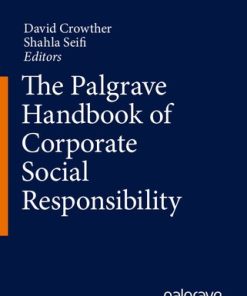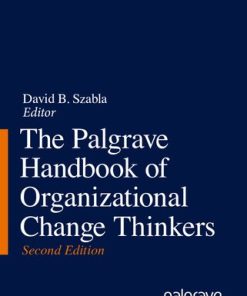The Palgrave Handbook of Survey Research 1st Edition David L. Vannette
$50.00 Original price was: $50.00.$25.00Current price is: $25.00.
The Palgrave Handbook of Survey Research – Ebook Instant Download/Delivery ISBN(s): 9783319543949,9783319543956,3319543946,3319543954

Product details:
- ISBN-10 : 3319543946
- ISBN-13 : 978-3319543949
- Author(s): David L. Vannette, Jon A. Krosnick
This handbook is a comprehensive reference guide for researchers, funding agencies and organizations engaged in survey research. Drawing on research from a world-class team of experts, this collection addresses the challenges facing survey-based data collection today as well as the potential opportunities presented by new approaches to survey research, including in the development of policy. It examines innovations in survey methodology and how survey scholars and practitioners should think about survey data in the context of the explosion of new digital sources of data. The Handbook is divided into four key sections: the challenges faced in conventional survey research; opportunities to expand data collection; methods of linking survey data with external sources; and, improving research transparency and data dissemination, with a focus on data curation, evaluating the usability of survey project websites, and the credibility of survey-based social science.
Table contents:
Section 1. Conventional Survey Research
1. Assessing the Accuracy of Survey Research
2. The Importance of Probability-Based Sampling Methods for Drawing Valid Inferences
3. Sampling for Single and Multi-Mode Surveys Using Address-Based Sampling
4. Evidence About the Accuracy of Surveys in the Face of Declining Response Rates
5. Sampling to Minimize Nonresponse Bias
6. Cross-National Issues in Response Rates
7. Choosing a Mode of Survey Data Collection
8. Mixed-Mode and Mixed-Device Surveys
9. The Use and Effects of Incentives in Surveys
10. Methods for Determining Who Lives in a Household
11. Harmonization for Cross-National Comparative Social Survey Research: A Case Study Using the “Private Household” Variable
12. Answering for Someone Else: Proxy Reports in Survey Research
13. Improving Question Design to Maximize Reliability and Validity
14. Cognitive Interviewing in Survey Design: State of the Science and Future Directions
15. Survey Interviewing: Departures from the Script
16. How to Improve Coding for Open-Ended Survey Data: Lessons from the ANES
17. Applying Human Language Technology in Survey Research
18. Maintaining Respondent Trust and Protecting Their Data
19. Tackling Panel Attrition
20. Respondent Attrition Versus Data Attrition and Their Reduction
21. Best Practices for Creating Survey Weights
Section 2. Opportunities to Expand Data Collection
22. New Kinds of Survey Measurements
23. The Role of Surveys in the Era of “Big Data”
24. Getting the Most Out of Paradata
25. Open Probability-Based Panel Infrastructures
26. Collecting Interviewer Observations to Augment Survey Data
27. “Just One More Thing”: Using Leave-Behind Measurement Supplements to Augment Survey Data Collection
28. Ecological Momentary Assessment in Survey Research
29. Biomarkers in Representative Population Surveys
30. Measuring Past Events Using Calendar Aids
31. Collecting Social Network Data
Section 3. Linking Survey Data with External Sources
32. Methods of Linking Survey Data to Official Records
33. Linking Individual-Level Survey Data to Consumer File Records
34. Linking Survey Data to Administrative Records in a Comparative Survey Context
35. Linking Survey Data with the Catalist Commercial Database
36. Challenges and Opportunities in Collecting Election Administration Data
37. Challenges with Validating Survey Data
38. The Promise of Collaborative Data Sharing Across Research Sectors
Section 4. Improving Research Transparency and Data Dissemination
39. The Importance of Data Curation
40. Improving the Usability of Survey Project Websites
41. The Role of Transparency in Maintaining the Legitimacy and Credibility of Survey Research
42. Evidence-Based Survey Operations: Choosing and Mixing Modes
43. Best Practices for Survey Research
Section 5. Detailed Chapters
44. Reasons for Optimism About Survey Research
45. Probability Versus Non-Probability Methods
46. Address-Based and List-Based Sampling
47. The Impact of Survey Non-response on Survey Accuracy
48. Optimizing Response Rates
49. Data Collection Mode
50. Survey Incentives
51. Building Household Rosters Sensibly
52. Proxy Reporting
53. Questionnaire Design
54. Cognitive Evaluation of Survey Instruments
55. Interviewer Deviations from Scripts
56. Coding Open Responses
57. What HLT Can Do for You (and Vice Versa)
58. Confidentiality, Privacy, and Anonymity
59. Panel Attrition
60. Computation of Survey Weights
61. Paradata
62. Interviewer Observations
63. Leave-Behind Measurement Supplements
64. Ecological Momentary Assessment and Experience Sampling
65. Biomarkers
66. Specialized Tools for Measuring Past Events
67. Linking Survey Data to Official Government Records
68. Linking Knowledge Networks Web Panel Data with External Data
69. History and Promise and Blending Survey Data with Government Records on Turnout
70. Improving Information Quality and Availability Through Interactions Between Government and Academic, and Industry Survey Research Sectors
71. Metadata and Preservation
72. Usability of Survey Project Websites
73. Research Transparency and the Credibility of Survey-Based Social Science
People also search:
the palgrave handbook
the palgrave handbook of the history of surgery
the palgrave handbook of ethnicity
the palgrave handbook of survey research
the palgrave handbook of methods for media policy research
palgrave handbook of survey research
You may also like…
Business & Economics - Responsibility and Business Ethics
The Palgrave Handbook of Corporate Social Responsibility 1st 2021 Edition David Crowther
Education Studies & Teaching - Teaching & Teacher Training
The Palgrave Handbook of Teacher Education Research 1st edition
Business & Economics - Management & Leadership
The Palgrave Handbook of Organizational Change Thinkers 2nd Edition David B. Szabla
Politics & Philosophy - Politics
The Palgrave Handbook Of Populism 1st Edition by Michael Oswald 3030808037 9783030808037
Media
The Palgrave Handbook of Media and Communication Research in Africa Bruce 1st Edition Mutsvairo
Politics & Philosophy
The Palgrave Handbook of Ethics in Critical Research Catriona Ida Macleod
Politics & Philosophy - Cultural
dictionaries & phrasebooks
The Palgrave Handbook of Applied Linguistics Research Methodology 1st ed. Edition Aek Phakiti
Mathematics - Optimization. Operations Research












